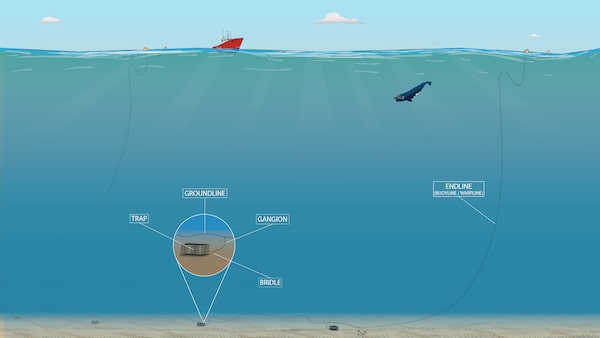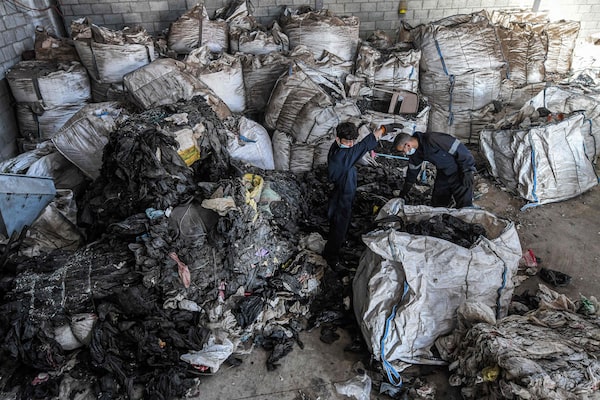If you’re reading this on the web or someone forwarded this e-mail newsletter to you, you can sign up for Globe Climate and all Globe newsletters here.
Good afternoon, and welcome to Globe Climate, a newsletter about climate change, environment and resources in Canada.
More than a year ago, The Globe launched the Climate Innovators and Adaptors digital hub in partnership with Rolex. You’ve probably seen examples of our visually driven journalism that highlights the people, communities and companies who are innovating ways to fight climate change.
We’re happy to report that this partnership will continue through 2023, with an aim to keep bringing you the best in climate solutions-based journalism. And in case you were curious: while Rolex supports the initiative financially, the company has no say in what stories The Globe covers or how we cover them.
Now, let’s catch you up on other news.
Noteworthy reporting this week:
- Indigenous conservation: The Taku River Tlingit declares large portion of British Columbia river watershed a protected area
- Transition: How fuel giant Parkland is adapting to a low-carbon world
- Policy: Canada to ban cosmetic testing on animals
- Oil and gas: Tilbury energy project emerges as battleground over planned LNG exports from Canada
- Rewriting the book on cold-weather fruit cultivation: How a Quebec farm is hoping to shape the future of strawberry growing
- From The Narwhal: What’s an MZO, anyway? Ontario’s obscure land zoning stirs controversy in Durham Region
A deeper dive
Fishing-gear entanglements are leading cause of death for these endangered whales
Jenn Thornhill Verma is a freelance climate writer for The Globe. For this week’s deeper dive, we give you a taste of her most recent Rolex story, with some excerpts about new, ropeless fishing gear.
North Atlantic right whales are estimated at 340 animals, down from a recent peak of about 480 over a decade ago, and dwindling compared to a population estimated to be at least ten times that 500 years ago. While right whales no longer face the threat of commercial whaling – the initial cause of the population’s plummet – human interactions pose the animal’s greatest existential threat.
The whales cover a massive geography, travelling from their spring and summer feeding grounds off northeastern Canada and the United States to winter calving grounds off southeastern U.S. Along the way, they face great risks from marine vessel strikes, ocean noise pollution and climate change, which is shifting the right whales’ preferred food source (small crustaceans called copepods) and usual geographic distribution (further north).
But the leading cause of serious injury and death to right whales is entanglements in vertical-line (fixed) gear, marked by a floating buoy and anchored by vertical rope to a trap, pot or net.
Ropeless or on-demand gear uses no fixed vertical ropes or lines, which removes the key threat to the whales, while allowing fishermen to do their job. But since the gear is undergoing testing and not yet widely adopted, most of the fishing gear in the water still poses a threat to North Atlantic right whales.
New import provisions to the Marine Mammal Protection Act, introduced in 2017, specifically ban the import of fish caught with commercial fishing technology that kills or seriously injures marine mammals in excess of U.S. standards. Canada is among the more than 130 countries to have submitted its required reporting to NOAA fisheries to demonstrate compliance with that provision, which formally took effect in December, 2022.
With fishing-gear entanglements as the leading cause of death for the imperilled whales, Canada must ramp up efforts to make best practices more common. Moving to on-demand gear is even more urgent as the U.S. – Canada’s top buyer of snow crab and Atlantic lobster, which are also Canada’s highest-earning seafood exports – undertakes its review of imported seafood.
Meanwhile, as the race to retrofit and scale on-demand fishing gear continues, developers are moving rapidly to address issues of interoperability, already prototyping gear-mapping technology, so fishers can avoid setting their gear over one another’s and DFO fisheries managers can regulate the gear in the water.


These illustrations demonstrate the difference between standard lobster trapping gear versus on demand .The Globe and Mail
What else you missed
- Federal budget should boost energy transition, show fiscal prudence: Business Council CEO
- Electricity constraints force Canada’s first LNG terminal to delay renewable shift
- Climate activist Greta Thunberg detained by German police at mine protest
- B.C. court tosses lawsuit alleging province broke rules to report emission targets
- Donor support helped postponed famine in Somalia, but crisis still looms: World Food Program chief
- Brazil’s new President works to reverse Amazon deforestation
You also missed new from Davos, at the World Economic Forum meeting:
A game changing U.S. climate bill stoked EU subsidy fears, and the UN chief called on business leaders at Davos to make ‘credible’ and accountable net-zero pledges. Meanwhile, climate activist Greta Thunberg met with the IEA chief in Davos, demanding end to fossil fuel investments. Also, a different type of energy transition has taken place at this year’s meeting: big oil comes in from the cold on energy transition.
Opinion and analysis
Dan Boyce: Canada’s forage fish are dwindling, placing the Atlantic economy under threat
Kelly Cryderman: Dispute over Ottawa’s Just Transition to become the top issue in Alberta election
Jen Gerson: The ‘Just Transition’ fracas is just noise – for now
Green Investing
Nine terms you need to know to be a more responsible investor
Responsible investing. ESG integration. Sustainable investing. Shareholder engagement. Divestment. Negative screening. Positive screening. Thematic investing. Impact investing.
A recent report by Franklin Templeton Investments noted that 61 per cent of Canadian respondents deemed environmental, social and governance (ESG) issues to be important considerations for investing. Only four in 10 knew what ESG involves.
Those interested in pursuing this style of investing in 2023 need to know these nine terms in the RI glossary.
Also read: Pension funds improving on climate but overall still falling short: report
Making waves
Book review: The Song of the Cell asks us to ponder the huge implications of microscopic biology
To contemplate the living cell is to consider the stuff humans are made of, for cells are the essential building block of life. In The Song of the Cell, Siddharta Mukherjee tells the story of their continuing discovery. He explores the significance, now that our knowledge allows us to alter cells within our own bodies.
Mukherjee’s deep engagement with cell biology and cellular medicine animates The Song of the Cell. Cell biology becomes a rich journey – part historical saga, part detective story – and also leans into futurism. The great achievement of The Song of the Cell is to transcend the gap between the technical knowledge and the human drama of this field of science. Mukherjee shows us that cell biology already deeply informs our present lives, but so much shimmers in the near-horizon, at once microscopic in detail, and massive in its implications for humanity.
Read the full book review today
Do you know an engaged individual? Someone who represents the real engines pursuing change in the country? Email us at GlobeClimate@globeandmail.com to tell us about them.
Photo of the week

Workers sort through sacks of plastic waste at a workshop of the startup company "TileGreen", where it is recycled into eco-friendly interlocking tiles used in outdoor walkways, about 60 kilometres east of Egypt's capital. Entrepreneurial young Egyptians are helping combat their country's plastic problem, making slow progress in dealing with waste that would usually end up in landfill and waterways, including the Nile. At the factory on the outskirts of Cairo, massive mounds of white, blue and black plastic is funnelled into machines, shredded and liquefied. It then emerges emerge as dark, compact bricks, as the TileGreen start-up turns even single-use plastic into outdoor pavers that can be used for walkways and garages.AHMED HASAN/AFP/Getty Images
Guides and Explainers
- Want to learn to invest sustainably? We have a class for that: Green Investing 101 newsletter course for the climate-conscious investor. Not sure you need help? Take our quiz to challenge your knowledge.
- We’ve rounded up our reporters’ content to help you learn about what a carbon tax is and just generally how Canada will change because of climate change.
- We have ways to make your travelling more sustainable and if you like to read, here are books to help the environmentalist in you grow, as well as a downloadable e-book of Micro Skills - Little Steps to Big Change.
Catch up on Globe Climate
- How the Canadian military plans to go green
- Destinations for the 2023 environmentally conscious traveller
- COP15 reaches historic biodiversity agreement
- Biodiversity, genetics, and commercial gain at COP15
We want to hear from you. Email us: GlobeClimate@globeandmail.com. Do you know someone who needs this newsletter? Send them to our Newsletters page.